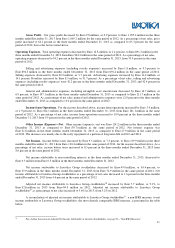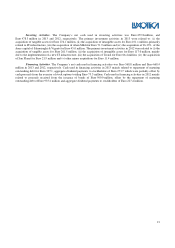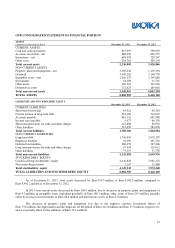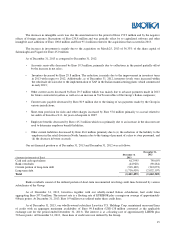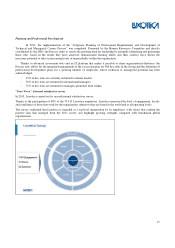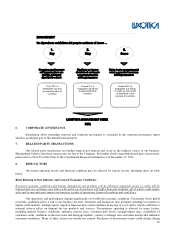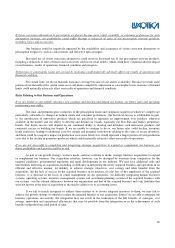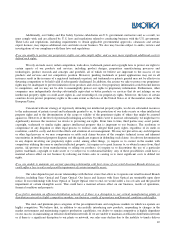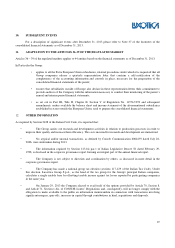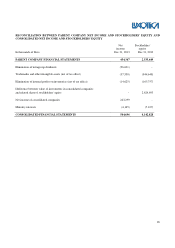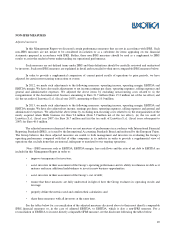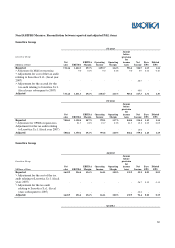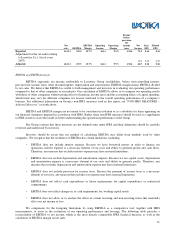LensCrafters 2013 Annual Report Download - page 26
Download and view the complete annual report
Please find page 26 of the 2013 LensCrafters annual report below. You can navigate through the pages in the report by either clicking on the pages listed below, or by using the keyword search tool below to find specific information within the annual report.
21
If we are unable to achieve and manage growth, operating margins may be reduced as a result of decreased efficiency of
distribution.
In order to achieve and manage our growth effectively, we are required to increase and streamline production and
implement manufacturing efficiencies where possible, while maintaining strict quality control and the ability to deliver
products to our customers in a timely and efficient manner. We must also continuously develop new product designs and
features, expand our information systems and operations, and train and manage an increasing number of management level
and other employees. If we are unable to manage these matters effectively, our distribution process could be adversely
affected and we could lose market share in affected regions, which could materially adversely affect our business prospects.
If we do not correctly predict future economic conditions and changes in consumer preferences, our sales of premium
products and profitability could suffer.
The fashion and consumer products industries in which we operate are cyclical. Downturns in general economic
conditions or uncertainties regarding future economic prospects, which affect consumer disposable income, have historically
adversely affected consumer spending habits in our principal markets and thus made the growth in sales and profitability of
premium-priced product categories difficult during such downturns. Therefore, future economic downturns or uncertainties
could have a material adverse effect on our business, results of operations and financial condition, including sales of our
designer and other premium brands.
The industry is also subject to rapidly changing consumer preferences and future sales may suffer if the fashion and
consumer products industries do not continue to grow or if consumer preferences shift away from our products. Changes in
fashion could also affect the popularity and, therefore, the value of the fashion licenses granted to us by designers. Any event
or circumstance resulting in reduced market acceptance of one or more of these designers could reduce our sales and the
value of our models from that designer. Unanticipated shifts in consumer preferences may also result in excess inventory and
underutilized manufacturing capacity. In addition, our success depends, in large part, on our ability to anticipate and react to
changing fashion trends in a timely manner. Any sustained failure to identify and respond to such trends could materially
adversely affect our business, results of operations and financial condition and may result in the write-down of excess
inventory and idle manufacturing facilities.
If we do not continue to negotiate and maintain favorable license arrangements, our sales or cost of sales could suffer.
We have entered into license agreements that enable us to manufacture and distribute prescription frames and
sunglasses under certain designer names, including Chanel, Prada, Miu Miu, Dolce & Gabbana, Bulgari, Tiffany & Co.,
Versace, Burberry, Polo Ralph Lauren, Donna Karan, DKNY, Paul Smith, Brooks Brothers, Stella McCartney, Tory Burch,
Coach, Armani and Starck Eyes. These license agreements typically have terms of between three and ten years and may
contain options for renewal for additional periods and require us to make guaranteed and contingent royalty payments to the
licensor. We believe that our ability to maintain and negotiate favorable license agreements with leading designers in the
fashion and luxury goods industries is essential to the branding of our products and, therefore, material to the success of our
business. Accordingly, if we are unable to negotiate and maintain satisfactory license arrangements with leading designers,
our growth prospects and financial results could materially suffer from a reduction in sales or an increase in advertising costs
and royalty payments to designers. For the years ended December 31, 2013 and 2012, no single license agreement
represented greater than 5% of total sales.
As we operate in a complex international environment, if new laws, regulations or policies of governmental organizations, or
changes to existing ones, occur and cannot be managed efficiently, the results could have a negative impact on our
operations, our ability to compete or our future financial results.
Compliance with European, U.S. and other laws and regulations that apply to our international operations increases
our costs of doing business, including cost of compliance, in certain jurisdictions, and such costs may rise in the future as a
result of changes in these laws and regulations or in their interpretation or enforcement. We have implemented policies and
procedures designed to facilitate our compliance with these laws and regulations, but there can be no assurance that our
employees, contractors or agents will not violate such laws and regulations or our policies. Any such violations could
individually, or in the aggregate, materially adversely affect our financial condition or operating results.


